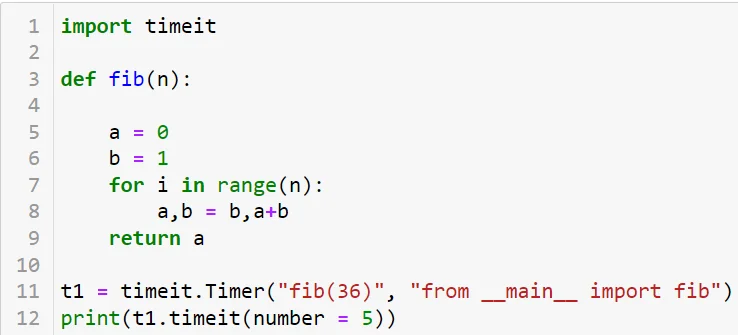Resolved: How do Timer() and timeit() work?
Good evening. What's the difference between Timer() and timeit()? It's not clear how they work. Why "timeit.Timer("fib(36)", "from greetings import fib")" has 2 strings inside and why "t1.timeit(5)" has a 5 inside? What do they mean? Thank you
Hey Alessandro,
Thank you for your question!
First, a couple of things to note in Giles' example. There is the module timeit which Giles imports on line 160. Then, there is the class Timer which he uses on lines 163 and 166 - it has a method timeit() which he uses on lines 164 and 167. Lastly, there exists a separate method timeit which Giles doesn't use in this example. It directly creates an instance of the Timer class. Let me demonstrate this with two examples that perform the same task.
1. Using the Timer class and its timeit() method

As you can find in the documentation, Timer has a couple of parameters - stmt (statement), setup, timer (which is a bit more technical, so I won't mention it below), and globals. In stmt, you specify the piece of code whose execution time you want to get - in our case, that is fib(36), so we write it as a string. Now, we move on to the setup parameter. As the timeit module works within its own namespace, it won't recognize the function fib(n). Therefore, we need to tell timeit that we want it to look in our namespace. This is done using the code from the screenshot above. As it turns out, there is another way to do it by making use of the globals parameter:

In contrast, Giles' fib function is defined in the greetings module, so he imports it from there. The globals parameter would have not worked for him.
So far, in line 11, we've created an instance of the Timer class. In order to get the time for execution, however, we need to call Timer's timeit() method and specify the number of times we want our code to be executed through the number parameter. By default this number is quite big - 1,000,000. However, we can change it by setting the number parameter to 5, for example. Running this piece of code, we will obtain the time for execution.
2. Another way of arriving at the same result is by directly using the timeit() method from the timeit module. It is done as follows:

Note that we can directly specify the number parameter. Note also that you can again use the setup parameter instead of globals:

It becomes very intuitive once you try it out a couple of times. I hope this helps! :)
Kind regards,
365 Hristina
Thank you very much!